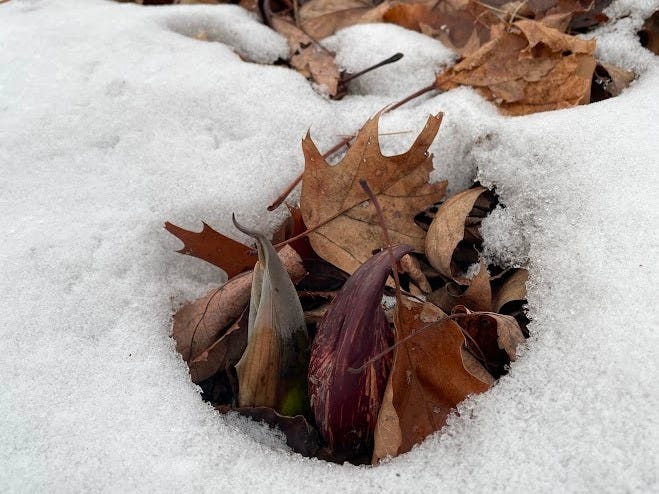Stop and smell the skunk cabbage
At last, the time is here when our first New England wildflower is poking up out of the ground and is poised to start blooming this week: skunk cabbage. Aptly named for its funky smell, it is a true harbinger of spring in Vermont.

It does not look like the flowers that we are accustomed to in New England—that’s because it’s in the same family as many tropical plants (Araceae), which we are mostly familiar with as houseplants (think: peace lily).
It’s still winter—ten more days until the vernal equinox!—and the ground is still frozen and mostly blanketed in snow and ice. Skunk cabbage is undeterred. It has a rare trait—thermogenesis—where it creates its own heat, melting through the ice and snow, ready to bloom no matter what this spring brings.
If you’re local to Burlington, there’s a great patch of skunk cabbage right off the bike path, just south of the Leddy ice rink (shown here in this reel that I made last March!). If elsewhere, check out wet woods and stream banks near you. Spend a few minutes paying attention to our stinky, stubborn spring neighbors, and let your mind wander.
Nevertheless, she is persisting
On Saturday, I spent golden hour in the woods with the Leddy Park skunk cabbages. Finding some quiet time in the woods always helps me recharge, especially now, when it’s hard to escape the constant overwhelm in the news cycle.
Saturday, especially being International Women’s Day, I could not help but admire the persistence of the skunk cabbage flowers—first emerging now as female, then later turning male to produce pollen—reliably returning to their role in the forest, despite what the world is throwing at them this spring.
Our new administration is trying to flood the zone—overloading us with chaos, corruption, and disinformation to exhaust our capacity to persist in the face of it all. We’re seeing the erasure of key words at the federal level, amazing researchers losing their jobs locally, and the list goes on and on.
But you know what? Skunk cabbage thrives in a flood. Water disperses its seeds of persistence to new ground. So, although we humans don’t necessarily thrive in a flood, taking a moment to pay attention to our first wildflower can still offer lessons of growth, persistence, and building our own capacity and resources to take on whatever comes at us.

Stopping to pay attention to the natural world, even if just for a few minutes, can offer endless opportunities for inspiration and grounding.
Feel free to leave a note about what you’re paying attention to lately as spring begins to unfold.
All photos are mine unless otherwise noted.




thank you Leslie! I did not know skunk cabbage created it's own heat or that they started out as female and change to male! Love your posts!